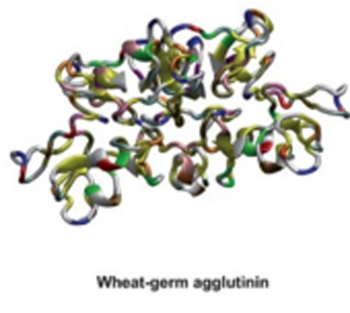William Davis's Blog: Dr. Davis Infinite Health Blog, page 95
January 31, 2017
Which beers are safe for the Wheat Belly lifestyle?
Football games, tailgating and beer always seem to go hand in hand. This can be problematic when you are adhering to a grain-free lifestyle. Virtually all ales, beers, malt liquors, and lagers are brewed from grains.
Thus, there are measurable grain protein residues present in most beers— generally 1 to 2 grams per 12 ounces. This is not a lot, but it’s enough to stimulate appetite, provoke inflammation, and initiate autoimmunity.
People with celiac disease or the most extreme forms of gluten sensitivity should avoid beers altogether, except those designated gluten-free. I have my doubts about even the gluten-free products, since all are brewed from the seeds of grasses.
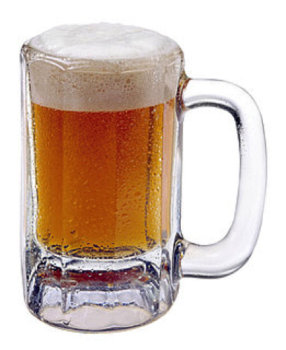 If a beer is designated gluten-free, no gliadin or gluten should be present (the official cutoff is fewer than 20 parts per million), but there is still potential for uncertain reactions from other grain proteins. Those who do not have celiac disease or gluten sensitivity seem to do okay with beers brewed from sorghum and rice but which also include barley malt, though you may have to experiment and see how your body reacts to these beers before you decide whether or not to consume them regularly. Of all alcoholic beverages, beer is the most hazardous, so be careful.
If a beer is designated gluten-free, no gliadin or gluten should be present (the official cutoff is fewer than 20 parts per million), but there is still potential for uncertain reactions from other grain proteins. Those who do not have celiac disease or gluten sensitivity seem to do okay with beers brewed from sorghum and rice but which also include barley malt, though you may have to experiment and see how your body reacts to these beers before you decide whether or not to consume them regularly. Of all alcoholic beverages, beer is the most hazardous, so be careful.
If you must drink it, here are 5 of the least problematic brews. – Tweet this!
Bard’s gluten-free beers. Brewed from sorghum without barley, this beer is truly gluten-free. As with many gluten-free beers, however, it’s high in carbs, and therefore you should not drink more than one per day (14.2 g carbohydrates per 12-ounce bottle).
Bud Light and Michelob Ultra. Bud Light, made by Anheuser-Busch, is brewed from rice but also contains barley malt. The most severely gluten-sensitive people should therefore not indulge in this beer because of the gluten content. But most of us who are just avoiding wheat but who aren’t gluten-sensitive can safely consume this brand without exposing ourselves to the undesirable effects of grains. One 12-ounce bottle contains 6.6 g of carbohydrates. Michelob Ultra is likewise brewed from rice with barley malt. It is also low in carbohydrates, with 2.6 g per 12-ounce
Redbridge. Redbridge is brewed from sorghum and is not brewed with wheat or barley. It is therefore confidently gluten-free, though it’s still brewed from the seed of a grass. The carbohydrate content is a bit high at 16.4 g per bottle; have more than one beer and the carbohydrates begin to stack up.
Green’s gluten-free beers. UK brewer Green’s provides several gluten-free choices made from sorghum, millet, buckwheat, brown rice, and “deglutenised” barley malt. They are not grain-free and have low quantities of grain proteins. So, tread carefully here, and make judgments based on your individual experience. The carbohydrate content of these beers is slightly less than most others, ranging from 10 to 14 g per 330-ml bottle.
In addition to these choices, I have seen some microbreweries starting to jump on the gluten-free bandwagon.
Look for beers brewed from chicory and other ingredients. – Tweet this!
Enjoy and may the best team win!
Yours in grainless health,
Dr. William Davis
The post Which beers are safe for the Wheat Belly lifestyle? appeared first on Dr. William Davis.
January 27, 2017
The next Wheat Belly Detox Challenge starts Tuesday, February 7th!
The next Wheat Belly 10-Day Grain Detox Challenge is scheduled to start Tuesday, February 7th! – Tweet this!
Through my New York Times bestseller, Wheat Belly, millions of people learned how to reverse years of chronic health problems by removing wheat from their daily diets. Now, I have created an easy and accessible 10-Day Detox Program.
The Wheat Belly 10-Day Grain Detox supplies you with carefully designed meal plans and delicious recipes to fully eliminate wheat and related grains in the shortest time possible. Perfect for those who may have fallen off the wagon or for newcomers who need a jump-start for weight loss, this new addition to the Wheat Belly phenomenon guides you through the complete 10-Day Detox experience.
In addition to the brand-new quick-start program, I’ll teach you
How to recognize and reduce wheat-withdrawal symptoms,
How to avoid common landmines that can sabotage success
How to use nutritional supplements to further advance weight loss and health benefits.
The “Wheat Belly 10-Day Grain Detox” also includes
Inspiring testimonials from people who have completed the program (and have now made grain-free eating a way of life)
Exciting new recipes to help get your entire family on board.
To join the Detox Challenge:
Step 1
Get the book. And read it (at least the first 5 chapters). Detox Challenge participants should be informed and active in order to get the most out of the challenge and private Facebook group.
Amazon: http://amzn.to/1JqzMea
Barnes & Noble: http://bit.ly/wheatbelly10daygraindetox-bn
Indiebound: http://bit.ly/1KwcFTQ
Step 2
Come join the Private Facebook Group.
http://bit.ly/WheatBelly-PrivateFBGroup
Step 3
Head back to the Private Facebook Group starting October 25th (the day before the official start of the Challenge) and onwards for tips, videos, and discussions to help you get through your detox and reprogram your body for rapid weight loss and health. Dr. Davis will be posting video instructions and answers to your questions.
Need support? Lapsed and want to get back on board?
Join the thousands of people who are losing weight and regaining health by following the Wheat Belly 10-Day Grain Detox. Join us if you desire support through the sometimes unpleasant process of wheat/grain detoxification and withdrawal or if you are among those who previously followed the program but lapsed, and now want to get back on board as confidently as possible—this Detox Challenge was made for you.
Yours in grainless health,
Dr. William Davis
The post The next Wheat Belly Detox Challenge starts Tuesday, February 7th! appeared first on Dr. William Davis.
January 24, 2017
Don’t Let Grains Ruin Your Skin
Grains can play havoc with your skin. The prolamin proteins, such as gliadin, trigger autoimmune skin reactions and turn antibodies against the skin, their lectins fan the fires of inflammation, their proteins provoke allergies, and amylopectins send blood sugar and insulin sky-high and provoke the skin-disrupting hormone insulin-like growth factor-1 (IGF). The whole grain inflammation package adds up to an impressive collection of skin conditions that can take a variety of forms, from simple red, itchy rashes to scaly, oily raised patches to large vesicles to gangrene. Because hair and nails are also considered part of the integumentary system, they, too, can be involved.
ACNE
Acne is a nearly universal problem in modern teenagers and adults. It is believed that acne is provoked by foods that trigger insulin and the hormone IGF. All grains raise blood sugar, and thereby insulin and IGF, to high levels, so they all share the capacity to create facial havoc. Sugary foods, such as soft drinks and candy also trigger insulin and IGF and can therefore share the blame as can the whey protein of dairy products that is unique among dairy components in its capacity to trigger insulin and IGF.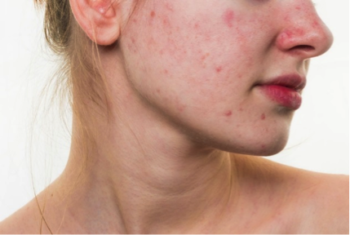
Repetitive high blood sugars lead to repetitive high insulin and IGF, which causes progressive resistance to insulin, leading to higher levels of insulin and IGF.
This cycle promotes acne. – Tweet this!
SEBORRHEA
This common red rash typically occurs along the sides of the nose and on the eyebrows, chest, back, and scalp (where it is called dandruff). The Malassezia fungus causes this rash. Interestingly, the same fungus populates the skin of most humans, even if they don’t have seborrhea. The relationship between grains and seborrhea is exceptionally consistent and predictable. Seborrhea is very common in grain consumers. It is also uncommon for seborrhea to not to improve or completely disappear with wheat elimination. In fact, I will go so far as to say that seborrhea, especially along both sides of the nose, is the signature skin rash of grain consumption, especially wheat, rye, and barley.
Typically, these rashes improve or disappear within a just few days of grain elimination. – Tweet this!
PSORIASIS
Psoriasis is an annoying and sometimes disfiguring rash that most commonly occurs on the elbows, knees, scalp, and back. Psoriasis typically takes the form of raised red plaques with a white sheen and covers a large area, though several other forms can occur. Conventional treatment usually involves steroid creams; the use of drugs typically reserved for cancer, such as methotrexate; immunosuppressive agents, such as cyclosporine; and nasty (and costly) intravenous agents such as etanercept and infliximab. Treatment can go on for years, even decades, and is plagued by incomplete responses.
Psoriasis can be yet another form of immune reaction to fragments of gliadin and other grain prolamin proteins.
While psoriasis has also been associated with celiac disease, it can occur without celiac disease and can be associated with an increased likely hood of a 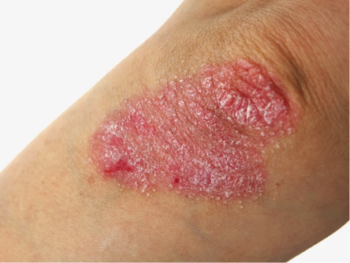 positive (IgA) antibody to gliadin. Wheat germ agglutinin (WGA) blocks vasoactive intestinal peptide (VIP) that permits the skin inflammation of psoriasis to emerge. A diet absent wheat, rye, and barley has been shown to be effective in improving psoriasis, particularly in people with higher levels of the IgA antibody to gliadin. The Wheat Belly experience has provided relief to countless psoriasis sufferers, the majority of whom enjoy improvement or complete relief from rashes, though it sometimes takes months to achieve compared to the much more rapid response in cases of seborrhea.
positive (IgA) antibody to gliadin. Wheat germ agglutinin (WGA) blocks vasoactive intestinal peptide (VIP) that permits the skin inflammation of psoriasis to emerge. A diet absent wheat, rye, and barley has been shown to be effective in improving psoriasis, particularly in people with higher levels of the IgA antibody to gliadin. The Wheat Belly experience has provided relief to countless psoriasis sufferers, the majority of whom enjoy improvement or complete relief from rashes, though it sometimes takes months to achieve compared to the much more rapid response in cases of seborrhea.
ECZEMA
The term “eczema” is applied to a wide range of rashes that are typically red, itchy, and raised and can occur anywhere on the body. Eczematous rashes are common; one third of the world’s population have experienced or will experience an episode at some time in their lives. Because eczematous rashes are, to some degree, driven by allergic processes, other allergic phenomena typically accompany eczema, such as asthma, allergic rhinitis and sinus congestion, acid reflux, eosinophilic esophagitis (esophageal inflammation) infantile colic, and allergic enterocolotis (small intestinal and colon inflammation).
People with celiac disease are three times more prone to eczema than people without celiac disease, while relatives of people with celiac disease (who don’t have celiac disease themselves) are twice as prone. Here’s the link to a relevant study.
Because eczema is common outside of celiac disease, there is no shortage of wild theories that blame this chronic, annoying, and sometimes disfiguring condition on everything from dust mites to neurosis to excessive cleanliness. As with any condition that is common and “unexplained,” we should always ask whether consumption of seeds of grasses might be at fault. Eczema has indeed been associated with various foods, including peanuts, dairy, soy, fish, and eggs, as well as all grains. Wheat, rye, and barley contain a smorgasbord of proteins that have been associated with eczema, asthma, and other forms of allergies. It remains unclear just what proportion of people with eczema can blame grains. Judging by the number of people who report relief from eczematous rashes within 5 to 7 days of giving up wheat and/or all grains, the effect wheat has upon this condition is substantial.
APHTHOUS STOMATITIS
This a mouthful of a disease, more commonly known as mouth full of ulcers or canker sores. This can range from a minor annoyance to a debilitating condition that is sometimes so painful that it interferes with eating and speaking. This condition is really a mixture of responses triggered by different causes, and there is an increased incidence in people with celiac disease.
However, the gliadin and related proteins of grains are among the causes, and a surprising proportion of non-celiac sufferers experience relief from guess what? That’s right: adopting a grain-free diet!
The number of skin conditions caused by grain consumption are simply too numerous to list in detail here, literally numbering in the hundreds. This is not to say that grains cause all skin conditions, but an astounding proportion of them are. And what other potential cause is so easy to correct, no nasty oral or intravenous drugs required, while providing an impressive list of other health benefits?
Yours in grainless health,
Dr. William Davis
The post Don’t Let Grains Ruin Your Skin appeared first on Dr. William Davis.
Don’t Let Grains Ruin Your Skin.
Grains can play havoc with your skin. The prolamin proteins, such as gliadin, trigger autoimmune skin reactions and turn antibodies against the skin enzymes, their lectins fan the fires of inflammation, their proteins provoke allergies, and their amylopectins send blood sugar and insulin sky-high and provoke the skin-disrupting hormone insulin-like growth factor-1 (IGF). The whole grain package adds up to an impressive collection of skin conditions that can take a variety of forms, from simple red, itchy rashes to scaly, oily raised patches to large vesicles to gangrene. Because hair and nails are also considered part of the integumentary system, they, too, can be involved.
ACNE
Acne is a nearly universal problem in modern teenagers and adults. It is believed that acne is provoked by foods that trigger insulin and the hormone IGF. All grains raise blood sugar, and thereby insulin and IGF, to high levels, so they all share the capacity to create facial havoc. Sugary foods, such as soft drinks and candy also trigger insulin and IGF and can therefore share the blame as can the whey protein of dairy products that is unique among dairy components in its capacity to trigger insulin and IGF.
Repetitive high blood sugars lead to repetitive high insulin and IGF, which causes progressive resistance to insulin, leading to higher levels of insulin and IGF.
This cycle promotes acne. – Tweet this!
SEBORRHEA
This common red rash typically occurs along the sides of the nose and on the eyebrows, chest, back, and scalp (where it is called dandruff). The Malassezia fungus causes this rash. Interestingly, the same fungus populates the skin of most humans, even if they don’t have seborrhea. The relationship between grains and seborrhea is exceptionally consistent and predictable. Seborrhea is very common in grain consumers. It is also uncommon for seborrhea to not to improve or completely disappear with wheat elimination. In fact, I will go so far as to say that seborrhea, especially along both sides of the nose, is the signature skin rash of grain consumption, especially wheat, rye, and barley.
Typically, these rashes improve or disappear within a just few days of grain elimination. – Tweet this!
PSORIASIS
Psoriasis is an annoying and sometimes disfiguring rash that most commonly occurs on the elbows, knees, scalp, and back. Psoriasis typically takes the form of raised red plaques with a white sheen and covers a large area, though several other forms can occur. Conventional treatment usually involves steroid creams; the use of drugs typically reserved for cancer, such as methotrexate; immunosuppressive agents, such as cyclosporine; and nasty (and costly) intravenous agents such as etanercept and infliximab. Treatment can go on for years, even decades, and is plagued by incomplete responses.
Psoriasis can be yet another form of immune reaction to fragments of gliadin and other grain prolamin proteins.
While psoriasis has also been associated with celiac disease, it can occur without celiac disease and can be associated with an increased likely hood of a  positive (IgA) antibody to gliadin. Wheat germ agglutinin (WGA) blocks vasoactive intestinal peptide (VIP), this permits the skin inflammation of psoriasis to emerge. A diet absent wheat, rye, and barley has been shown to be effective in improving psoriasis, particularly in people with higher levels of the IgA antibody to gliadin. The Wheat Belly experience has provided relief to countless psoriasis sufferers, the majority of whom enjoy improvement or complete relief from rashes, though it sometimes takes months to achieve compared to the much more rapid response in cases of seborrhea.
positive (IgA) antibody to gliadin. Wheat germ agglutinin (WGA) blocks vasoactive intestinal peptide (VIP), this permits the skin inflammation of psoriasis to emerge. A diet absent wheat, rye, and barley has been shown to be effective in improving psoriasis, particularly in people with higher levels of the IgA antibody to gliadin. The Wheat Belly experience has provided relief to countless psoriasis sufferers, the majority of whom enjoy improvement or complete relief from rashes, though it sometimes takes months to achieve compared to the much more rapid response in cases of seborrhea.
ECZEMA
The term “eczema” is applied to a wide range of rashes that are typically red, itchy, and raised and can or occur anywhere on the body. Eczematous rashes are common; one third of the world’s population have experienced or will experience an episode at some time in their lives. Because eczematous rashes are, to some degree, driven by allergic processes, other allergic phenomena typically accompany eczema, such as asthma, allergic rhinitis and sinus congestion, acid reflux, eosinophilic esophagitis (esophageal inflammation) infantile colic, and allergic enterocolotis (small intestinal and colon inflammation).
People with celiac disease are three times more prone to eczema than people without celiac disease, while relatives of people with celiac disease (who don’t have celiac disease themselves) are twice as prone. Here’s the link to corresponding study.
Because eczema is common outside of celiac disease, there is no shortage of wild theories that blame this chronic, annoying, and sometimes disfiguring condition on everything from dust mites to neurosis to excessive cleanliness. As with any condition that is common and “unexplained,” we should always ask whether consumption of seeds of grasses might be at fault. Eczema has indeed been associated with various foods, including peanuts, dairy, soy, fish, and eggs, as well as all grains. Wheat, rye, and barley contain a smorgasbord of
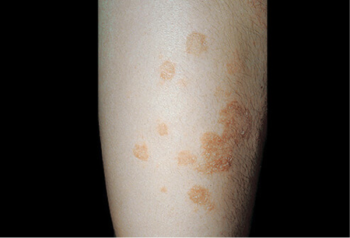 proteins that have been associated with eczema, asthma, and other forms of allergies. It remains unclear just what proportion of people with eczema can blame grains. Judging by the number of people who report relief from eczematous rashes within 5 to 7 days of giving up wheat and/or all grains, the effect wheat has upon this condition is substantial.
proteins that have been associated with eczema, asthma, and other forms of allergies. It remains unclear just what proportion of people with eczema can blame grains. Judging by the number of people who report relief from eczematous rashes within 5 to 7 days of giving up wheat and/or all grains, the effect wheat has upon this condition is substantial.
APHTHOUS STOMATITIS
This a mouthful of a disease, more commonly known as mouth full of ulcers or canker sores. This can range from a minor annoyance to a debilitating condition that is sometimes so painful that it interferes with eating and speaking. This condition is really a mixture of responses triggered by different causes, and there is an increased incidence in people with celiac disease.
However, the gliadin and related proteins of grains are among the causes, and a surprising proportion of non-celiac sufferers, experience relief from guess what? That’s right: adopting a grain-free diet!
The number of skin conditions caused by grain consumption are simply too numerous to list in detail here, literally numbering in the hundreds. This is not to say that grains cause all skin conditions, but an astounding proportion of them are. And what other potential cause is so easy to correct, no nasty oral or intravenous drugs required, while providing an impressive list of other health benefits?
Yours in grainless health,
Dr. William Davis
The post Don’t Let Grains Ruin Your Skin. appeared first on Dr. William Davis.
January 23, 2017
Super-Duper High-Fat Wheat Belly Yogurt
We celebrate fat on the Wheat Belly lifestyle.
With yogurt, it means we never eat the thin, insipid non-fat or low-fat stuff. We laugh at the anemic 2% yogurt that you can practically drink rather than eat–and they’re filled with sugar or high-fructose corn syrup, anyway.
You could go for the full-fat (3-6%, though typically 4% milk fat). Or you could go for the Super-Duper High-Fat Wheat Belly Yogurt made with heavy cream that is about 33-36% fat–really fatty. Almost like melted cream cheese, thick and rich.
Fat, including that in dairy, has been demonized. Ironically, it is clear that the fat is the best part of all and does not cause weight gain or cardiovascular disease. If there’s a problem with dairy (and I mean real problem, not just distress from lactose), it’s the protein casein beta A1 that has been associated with triggering autoimmune diseases like type 1 diabetes in children, as well as sudden infant death syndrome (from both infant and maternal consumption of dairy).
That is part of the beauty of making yogurt: lactate fermentation denatures (breaks down) much of the casein protein, reducing it to less harmful peptides. (Little intact protein remains.) Fermentation also reduces lactose content, as fermenting microbes convert lactose to lactic acid. And, when you make yogurt yourself, you can extend fermentation time to further denature casein and consume lactose, making it even safer.
If you want a really super-thick and rich yogurt, so rich that you don’t even need a sweetener, start with heavy whipping cream. You don’t need any special equipment: I stopped using yogurt makers years ago, when I learned that simply putting the cream in a glass bowl, placed in the oven at a temperature of around 300 degrees F for around one minute, just enough to warm the air, got the job done. (Avoid heating the glass dish beyond warm, as it will kill fermenting microbes.) You can use a food thermometer to be more precise, aiming for a liquid temperature of around 110 degrees F. “Seed” the cream with a starting culture that you purchase or a couple tablespoons of yogurt purchased at the grocery that contains live cultures (typically stated on the label). (I used a Trader Joe’s full-fat organic yogurt as the starter and had vigorous fermentation within 24 hours.)
Here’s what I did recently:
16 ounces heavy whipping cream (preferably organic)
2 tablepoons full-fat yogurt with live cultures or one packet starting culture
Combine whipping cream and starter in mediums-sized glass bowl. Place in oven as described above. Reheat oven every 3-4 hours; it’s okay to leave overnight without heating.
Voila: yogurt in 24 hours. Allow to ferment an additional 24 hours, continuing the periodic heating, to further ferment. Serve with blueberries, strawberries, or other topping. Shown in the photo is my result after 48 hours fermentation. Because it’s full of fat, you will find it wonderfully filling, as well as delicious with delectable mouthfeel. And it gives you further reason to make a rude gesture at the ridiculous U.S. Dietary Guidelines for Americans, AKA “How to eat in order to profit the processed food industry and agribusiness.”
The post Super-Duper High-Fat Wheat Belly Yogurt appeared first on Dr. William Davis.
January 16, 2017
Grains: Perfect Obesogens
Last week, I discussed the negative effects that grains, particularly gliadin-derived opiates, have on the human brain. This week, I want to discuss yet another ill-effect that they have had on your previously never ending battle with unwanted weight. I say previously, because you can win this battle.
You can conquer those cravings once and for all, but to do so you must understand how to disarm the enemy. Imagine triumphantly enjoying your healthy new lifestyle and wardrobe.
As I have discussed in Wheat Belly Total Health:
Gliadin-derived opiates drive appetite in an “I can never get enough to eat” way. –Tweet this!
The amylopectin A carbohydrate drives blood sugar highs, followed by blood sugar lows that launch a 2-hour cycle of hunger.
But there’s more…
Grains also contain wheat germ agglutinin (WGA), a lectin protein in wheat. The lectin proteins of grains are, by design, nature’s form of bodyguards. These toxins discourage molds, fungi, and insects from eating seeds of plants.
The lectins of rye, barley, and rice are structurally identical to WGA and share all its properties and are also often referred to as “WGA.” The only substantial difference is that rye, barley, and rice express a single form of lectin, while genetically more complex wheat expresses up to three different forms. WGA is indigestible and toxic, resistant to any breakdown in the human body, and unaltered by heat (cooking, baking, frying) or fermentation. WGA wreaks ill effects on everyone, regardless of whether you have celiac disease, gluten sensitivity, or no digestive issues at all.
WGA mimics the effects of insulin on fat cells.
When WGA encounters a fat cell, it acts just as if it were insulin, inhibiting the activation of fat release and blocking weight loss while making the body more reliant on sugar sources for energy.
WGA is also suspected of blocking leptin, the hormone of satiety charged with signaling your brain with a “stop eating” message when your stomach is full after, say, two trips to the all-you-can-eat buffet. In the presence of WGA, this signaling system is blocked, causing you to eat even after you are full, after you have taken in what you require for sustenance, making the chocolate cake, peach pie, and cheesecake at the end of the buffet irresistible— even when common sense, good judgment, and every other body signal tell you that you’ve had enough.
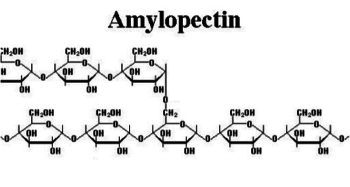 Making matters worse, high blood insulin provoked by amylopectin A causes belly fat to grow, viewed on the surface as a “muffin top” or “love handles” and seen on imaging tests such as CT scans as deep visceral fat encircling the abdominal organs. This belly fat is inflammatory fat that drives insulin levels up even further.
Making matters worse, high blood insulin provoked by amylopectin A causes belly fat to grow, viewed on the surface as a “muffin top” or “love handles” and seen on imaging tests such as CT scans as deep visceral fat encircling the abdominal organs. This belly fat is inflammatory fat that drives insulin levels up even further.
Insulin causes fat storage and prevents mobilization of fat for energy. – Tweet this!
Eat grains, increase appetite, provoke high insulin, grow belly fat, increase inflammation, provoke even higher blood insulin— around and around it goes, a vicious cycle that ensures weight gain. The entire process being initiated by a friendly looking piece of warm sourdough bread, blueberry muffin or bowl of organic oatmeal.
Therefore, I call wheat and its closely related grains not just perfect chronic poisons, but also perfect obesogens: foods that are perfectly crafted to make you fat, especially in the abdomen, what I call a wheat belly.
Yours in grainless health,
Dr. William Davis
The post Grains: Perfect Obesogens appeared first on Dr. William Davis.
January 11, 2017
It’s Time to Kick the Grain Habit.
Grains contain opiates. Not figuratively, but quite literally. These opiates are not too different from morphine or heroin. Yes, wheat and grains, cleverly disguised as a multigrain loaf of bread to make sandwiches or a hot, steamy plate of macaroni and cheese for the kids are mind-altering drugs. You and your kids are not oxycodone addicts, but when you consume wheat and grains, the results are not all that different.
How can this be?
When you consume the gliadin protein of wheat and the closely related proteins of other grains (secalin in rye, hordein in barley, zein in corn) they break down into smaller 4- or 5- amino-acid-long peptides. These peptides penetrate your brain and bind themselves to opiate receptors.
 Even selecting organic isn’t safe. – Tweet this!
Even selecting organic isn’t safe. – Tweet this!
This is true even if they are organic, traditional or heirloom, or sprouted. This is because grains contain toxic components naturally, only made worse by recent genetic manipulations.
In people with conditions such as bipolar illness and schizophrenia, they yield effects such as impulsive behavior and paranoia; in children with attention deficit disorder and autism, they cause behavioral outbursts and shorten attention spans; in people, prone to bulimia and binge eating disorder, they cause 24-hour-a-day food obsessions. In those prone to depression, they cause dark moods and even suicidal thoughts.
In people without these conditions, grains only serve to trigger appetite in an irresistible, never-satisfied way. Most of us take in 400 calories (or more) per day from this appetite-increasing effect, sometimes as much as 1,000 or more calories per day. Some people even develop incapacitating and addictive relationships with food due to exposure to gliadin-derived opiates, often resulting food in obsessions in people prone to eating disorders.
Lack of Concentration, inability to focus, impaired learning, impaired decision-making ability, and sleepiness are exceptionally common after consuming wheat, rye, and barley. Gliadin-derived opiates are the most likely culprits behind these effects, given their known ability to affect the mind. It’s also likely that the blood sugar fluctuations caused by all grains contribute. This is especially true of the low blood sugar episodes experienced by those individuals dealing with hypoglycemia.
Attention-deficit hyperactivity disorder and autistic spectrum disorder. While these disorders are unrelated, they share a similar response to gliadin-derived opiates. Children and adults with these conditions experience behavioral outbursts, such as temper tantrums or emotional “storms” without reason, and they have an impaired capacity to sustain attention.
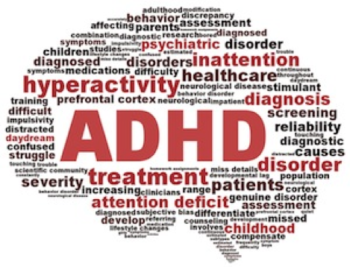 Kids with these conditions already have an impaired ability to learn and pay attention for more than a few seconds or minutes; grain-derived opiates just make it worse. A recent analysis demonstrated that kids with autism lack the markers for celiac disease (such as transglutaminase antibody), but they do have increased levels of antibodies to gliadin, especially if gastrointestinal symptoms like diarrhea are present.
Kids with these conditions already have an impaired ability to learn and pay attention for more than a few seconds or minutes; grain-derived opiates just make it worse. A recent analysis demonstrated that kids with autism lack the markers for celiac disease (such as transglutaminase antibody), but they do have increased levels of antibodies to gliadin, especially if gastrointestinal symptoms like diarrhea are present.
Paranoid schizophrenia. The worsening of paranoia, auditory hallucinations (hearing voices and receiving warnings or commands), and social disengagement were among the first observations made when researchers started studying the effects of wheat consumption on brain health, attributable to the gliadin protein– derived opiates. This effect may be confined to schizophrenics who express an autoimmune response to the gliadin protein, the group most likely to improve with wheat, rye, and barley avoidance.
Bipolar illness. We know that people with bipolar illness express higher levels of antibodies in response to the gliadin protein, similar to the phenomenon observed in schizophrenics. Gliadin-derived opiate peptides likely also play a role in generating the distortions in judgment and reality experienced with this condition.
Depression. If there is predisposition for depression, grains— especially wheat, rye, barley, and corn— can magnify or unmask that tendency.
 Depression due to the gliadin- and prolamin protein– derived opiates can be mild, resulting in a pervasive feeling of unhappiness and lack of interest, or it can be incapacitating and life threatening, complete with obsessive thoughts of suicide or self-harm. Both wheat and corn are also responsible for reductions in brain serotonin, which regulates mood. – Tweet this!
Depression due to the gliadin- and prolamin protein– derived opiates can be mild, resulting in a pervasive feeling of unhappiness and lack of interest, or it can be incapacitating and life threatening, complete with obsessive thoughts of suicide or self-harm. Both wheat and corn are also responsible for reductions in brain serotonin, which regulates mood. – Tweet this!
Obsessive-compulsive disorder. A person who has obsessive-compulsive disorder helplessly gives in to the impulse to obsessively and compulsively perform some action or engage in some thought— behaviors that have been associated with wheat consumption. It might be compulsive hand washing, or housecleaning, or checking and rechecking (and rechecking and rechecking) figures in a ledger. Being locked into such behavioral loops can be debilitating for the sufferer. These rituals can dominate their thoughts and behaviors, as well as sabotage success at school and work.
A world of research still needs to be performed to explore these mind-altering phenomena that develop in people who follow the standard advice to consume more grains. MRI, PET, and other brain-imaging modalities may reveal why and how schizophrenics tend to suffer more auditory hallucinations with grain consumption or why kids with autistic spectrum disorder experience impaired attention span. Notably, while some of these effects are associated with an immune response against one or more grain proteins, many are not.
There is hope. If you know that grains can worsen or cause deterioration in mental conditions, it also means that you know how to undo or lessen the severity of all of these effects.
Isn’t it time to kick the grain habit once and for all? – Tweet this!
Yours in grainless health,
Dr. William Davis
The post It’s Time to Kick the Grain Habit. appeared first on Dr. William Davis.
January 7, 2017
Wheat Belly Slim Guide now available!
The newest book in the Wheat Belly series is now at bookstores! The Wheat Belly Slim Guide: The Fast and Easy Reference for Living and Succeeding on the Wheat Belly Lifestyle.
As the subtitle suggests, the Wheat Belly Slim Guide is designed to be a portable reference to help navigate grocery stores, restaurants, health food stores, and your day-to-day life to help answer all those little questions that crop up like “What ingredients will I need to make a Wheat Belly Pizza?” or “What could I use to safely thicken my sauce for dinner tonight?”. Small enough to carry along in your purse, the Wheat Belly Slim Guide can come to your rescue whenever you need it.
Included in the Slim Guide are:
A summary of the Wheat Belly approach to cultivating bowel flora, including a list of prebiotic fiber sources
Wheat Belly safe sweeteners
Safe flours and meals for baking and breading
Safe thickeners
Wheat Belly Basic Recipes–All-Purpose Baking Mix, Focaccia Bread, ketchup, mayonnaise, salad dressings
The Top 10 Wheat Belly recipes of all time
A 7-day Menu Plan
Shopping lists
Wheat Belly Happy Hour: Safe alcoholic beverages
Avoiding common mistakes
Safe packaged foods
10 Rules for Eating Safely Outside the Home
And more, all meant to help you succeed in achieving your goals of losing weight and regaining extraordinary health.
You can find the Wheat Belly Slim Guide at major bookstores and these online retailers:
Amazon
Barnes & Noble
Books A Million
IndieBound
The post Wheat Belly Slim Guide now available! appeared first on Dr. William Davis.
January 5, 2017
3 Topics in the Wheat Belly Forefront.
 The status of bowel flora can spell the difference between having an autoimmune condition and not having an autoimmune condition, being diabetic or not being diabetic, being emotionally happy or not being happy, and developing colon cancer or not developing colon cancer. The composition of bowel flora and their ability to metabolize prebiotic fibers/resistant starches to butyrate and other fatty acids play important roles in insulin responses, nourishing and maintaining intestinal health, and intestinal permeability.
I like to think of bowel flora, the thousand or so species of microorganisms that inhabit the human gastrointestinal tract, as a garden.
Probiotics, i.e., anything that provides microorganisms believed to be among the desired inhabitants such as the various Lactobacillus or Bifidobacterial species, are like planting seeds for peppers and zucchini in your garden in spring time.
But what if you planted your seeds, then neglected to water and fertilize your garden?
Read my blog titled:
A blueprint to fertilize the garden called “bowel flora”
– Tweet this!
The status of bowel flora can spell the difference between having an autoimmune condition and not having an autoimmune condition, being diabetic or not being diabetic, being emotionally happy or not being happy, and developing colon cancer or not developing colon cancer. The composition of bowel flora and their ability to metabolize prebiotic fibers/resistant starches to butyrate and other fatty acids play important roles in insulin responses, nourishing and maintaining intestinal health, and intestinal permeability.
I like to think of bowel flora, the thousand or so species of microorganisms that inhabit the human gastrointestinal tract, as a garden.
Probiotics, i.e., anything that provides microorganisms believed to be among the desired inhabitants such as the various Lactobacillus or Bifidobacterial species, are like planting seeds for peppers and zucchini in your garden in spring time.
But what if you planted your seeds, then neglected to water and fertilize your garden?
Read my blog titled:
A blueprint to fertilize the garden called “bowel flora”
– Tweet this!

Using yeast
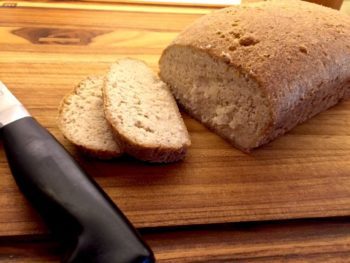 In the original Wheat Belly recipes to recreate breads, I largely avoided the use of yeast to generate “rise,” as I did not want to chance persistent adverse health effects from the yeast component of wheat and grain products, though the risk is small and applies to only a few percentage of people. While grain elimination needs to be an absolute 100%, 7-day-per-week process, I must admit that most people can do just fine by including yeast in their recipes.
In the original Wheat Belly recipes to recreate breads, I largely avoided the use of yeast to generate “rise,” as I did not want to chance persistent adverse health effects from the yeast component of wheat and grain products, though the risk is small and applies to only a few percentage of people. While grain elimination needs to be an absolute 100%, 7-day-per-week process, I must admit that most people can do just fine by including yeast in their recipes.
Doing so will restore the yeasty scent and flavors to non-grain baking, so much so that you could easily mistake a grain-free loaf of bread for a grain-based one. Lately, I’ve been playing around with non-grain bread recipes using yeast.
Read more in my blog titled: Should we use yeast? – Tweet this!
Monk Fruit
Monk fruit, also known as lo han guo, is a small round fruit found in Southeast Asia. It has been used for centuries in Eastern medicine as a cold remedy and digestive aid. Recently, it has been making its way to mainstream stardom in the western world as a sweetener. This fruit extract, or juice, is much sweeter than sugar, contains zero calories per serving and, unlike stevia, has no bitter aftertaste. The greater quantity of monk fruit contained in Wheat Free Market’s Virtue Sweetener makes this sweetener combination of monk fruit and erythritol four times sweeter than sugar, meaning much less is required compared to other sweetener brands and thereby reducing costs dramatically.
Yours in grainless health,
Dr. William Davis
PS: If you know someone who might be interested in learning about what the Wheat Belly lifestyle has to offer, send them to the Wheat Belly Blog and have them sign up to receive our emails.
The post 3 Topics in the Wheat Belly Forefront. appeared first on Dr. William Davis.
December 28, 2016
Get ready for a New Year’s challenge that will change your life forever.
How many times have you promised yourself to finally lose that unwanted weight? How many times have you failed? This is nothing more than an exercise in self-destruction.
This annual ritual results in lowering your self-esteem, not your weight. – Tweet this!
You can feel good about yourself again. You can achieve a physical makeover that makes you look 10, even 20 years younger without Botox, filler injections, surgery, or without any unwanted health consequences. You can enjoy shopping for clothing. You can eliminate the need for a multitude of prescription drugs. You simply need a plan. Not just any plan, you need a plan that is backed up by facts and results.
The Wheat Belly 10-Day Grain Detox is unlike all other detox programs. – Tweet this!
It does not involve cleansing your body with various juices or a magical concoction of supplements purported to remove body “toxins,” nor is it a timetable of daily enemas that complicate your meeting schedule. It is a detoxification process from the toxic effects of wheat and grains, a detoxification in the truest sense of the term. It is not just a matter of not eating wheat and grains or of eating “gluten-free” (as critics often perceive it).
This 10-day detox distills all the wisdom of the original Wheat Belly books and the lessons learned by the millions of people who have adopted this approach— incorporating the most insightful, cutting-edge, and effective strategies, and sharing them with you so that you can begin your path to weight and health success in a short 10 days.
This challenge brings with it a community of people who understand what you have gone through and are here to support you as you become the healthy person you desire to be.
It all begins with committing to the 10-day challenge. Just 10 days! Don’t you owe it to yourself?
No excuses…The next challenge begins on January 4th. You have time to prepare! – Tweet this!
Yours in grainless health,
Dr. William Davis
The post Get ready for a New Year’s challenge that will change your life forever. appeared first on Dr. William Davis.
Dr. Davis Infinite Health Blog
Recognize that this i The insights and strategies you can learn about in Dr. Davis' Infinite Health Blog are those that you can put to work to regain magnificent health, slenderness, and youthfulness.
Recognize that this is NOT what your doctor or the healthcare system provides, as they are mostly interested in dispensing pharmaceuticals and procedures to generate revenues. The healthcare INDUSTRY is not concerned with health--you must therefore take the reins yourself.
Dr. Davis focuses on:
--Real, powerful nutritional strategies
--Addresing nutrient deficiencies unique to modern lifestyles
--Deep insights into rebuilding the microbiome disrupted by so many modern factors
Follow Dr. Davis here and on social media and you can witness the extraordinary successes people enjoy on his programs. ...more
- William Davis's profile
- 160 followers





